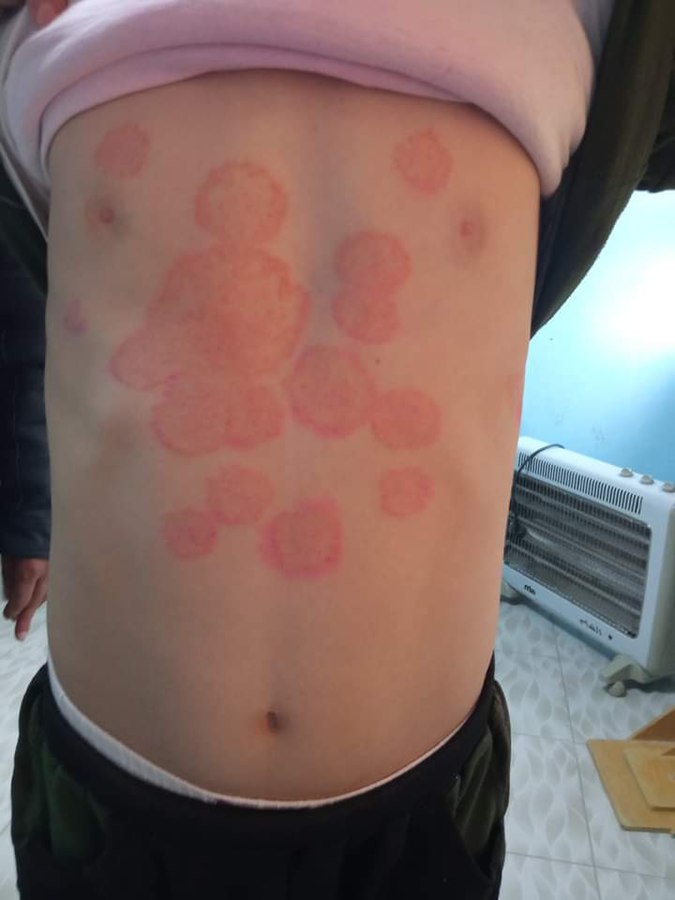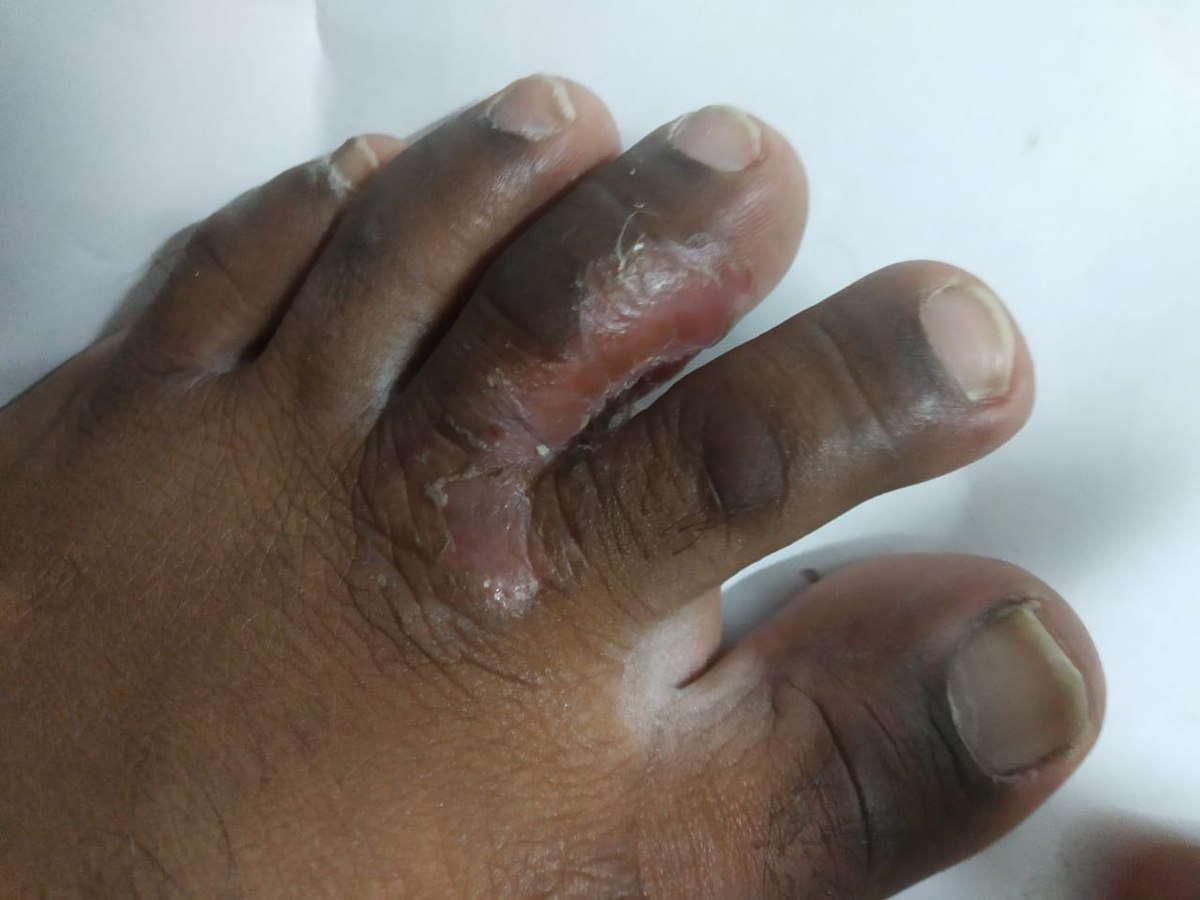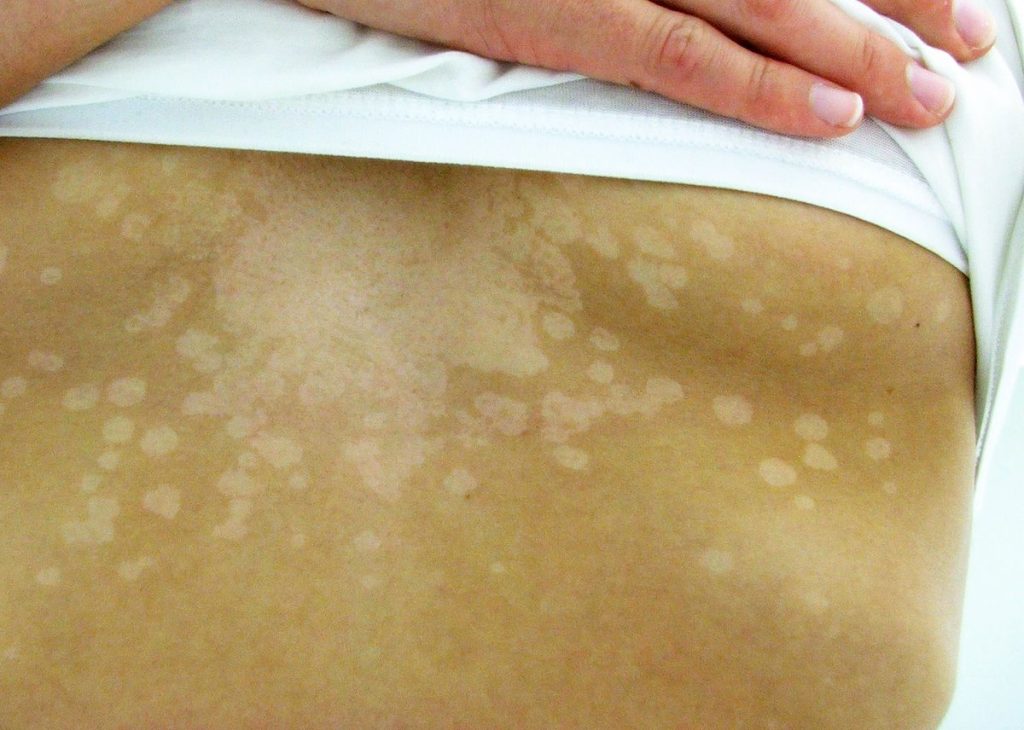16.20 Tinea Infection
Tinea infection refers to a fungal infection of the superficial layer of the skin. It is named specifically by the type of body part that is affected or the symptoms it causes:
- Tinea capitis affects the scalp.
- Tinea cruris, commonly known as jock itch, affects the groin area.
- Tinea pedis, commonly known as athlete’s foot, affects the feet.
- Tinea corporis, commonly known as ringworm, affects the trunk, neck, and extremities.
- Tinea versicolor also affects the extremities, trunk, and neck, but it is caused by a different type of fungus than tinea corporis. It causes changes in skin color, hence, the name for this condition.
All the tinea infections, except for tinea versicolor, are caused by dermatophytes. Dermatophytes are a type of fungi that require the keratin present in hair, nails, and skin to survive. Tinea versicolor is caused by Malassezia, the same fungus that is linked to seborrheic dermatitis. Risk factors for tinea versicolor are living in a warm and/or humid climate and is commonly experienced by adolescents and young adults but can also be experienced by infants and younger children. Other risk factors are pregnancy, oily skin, and the use of oil-containing lotions or creams. A family history of tinea versicolor and immunosuppression also increases the risk for developing tinea versicolor.[1],[2],[3],[4],[5]
Risk factors for other types of tinea infection previously described are living in hot and humid areas, wearing tight-fitting clothing or footwear, poor hygiene, excessive sweating, participating in contact sports, and immunosuppression. Having one type of tinea infection predisposes the client to becoming infected in another body part due to self-inoculation. Tinea capitis and tinea corporis are commonly seen in children who have not yet reached puberty. Risk for tinea pedis is increased with prolonged submersion in water or exposure to community pools or showers. Tinea pedis and tinea cruris are more commonly seen in males.[6],[7],[8],[9],[10]
Pathophysiology
Tinea corporis infection occurs when the skin of the client comes into contact with the skin of an infected person, animal, or soil. The dermatophyte attaches to the keratin in the skin and causes a fungal infection that triggers an immune response. Tinea capitis has a similar pathophysiology, except the dermatophyte invades the hair follicle as opposed to the skin. Tinea cruris can also be spread from person to person or from contaminated objects, such as a used towel. Tinea cruris can also be caused by tinea pedis if the client touches their feet and then their groin. Tinea pedis often occurs when the client walks barefoot and comes into direct contact with a dermatophyte, such as in locker rooms, showers, or public swimming pools. In cases of tinea versicolor, the Malassezia fungus is present on the skin as part of normal flora, but the process in which the fungus causes tinea versicolor infection is not well-understood. Unlike other forms of tinea infection, tinea versicolor is not contagious.[11],[12],[13],[14],[15]
Assessment (Recognize Cues)
Physical Exam
The signs and symptoms of each type of tinea infection are described in the following subsections.[16],[17],[18],[19],[20]
Tinea Corporis
- Red rash that is itchy and present on the extremities, trunk, and/or neck.
- Lesions are circle or oval in shape with reddened and scaly edges.
- There can be single or multiple lesions. See Figure 16.26[21] for an image of tinea corporis.

Tinea Capitis
- Round, red lesions that affect the scalp. The center of the lesion may appear normal, but the edges will be red and inflamed. Scaling may also be present. Lesions may spread to the lashes and brows.
- Itching
- Hair loss
Tinea Pedis
- Lesions appear on the toes or feet and are red with silver scales. See Figure 16.27[22] for an image of tinea pedis.
- Itching
- Peeling of skin
- Skin fissures
- May progress to toenails, causing onychomycosis. This leads to thick and discolored nails.

Tinea Cruris
- Reddened, scaly, and itchy rash in the groin and surrounding areas. The middle of the lesion may be clear. Edges of the lesions may be raised.
- Pain or irritation may be present.
Tinea Versicolor
- Multiple scaly lesions that are oval in shape. Skin lesions can be red or have increased or decreased skin pigmentation. See Figure 16.28[23] for an image of tinea versicolor.
- Lesions mostly affect the trunk and arms but can affect the face in children.
- Lesions may or may not itch.
- Hair thinning or loss may occur in the area of the lesions.
- Five different subtypes occur, and presentation varies slightly with each type.

Common Laboratory and Diagnostic Tests
Tinea infections are diagnosed clinically. Skin scrapings may be obtained and viewed under a microscope, or samples can be sent for a fungal culture to confirm the diagnosis. Tinea capitis and tinea versicolor can also be diagnosed with the help of a Wood’s lamp. This lamp allows the viewer to see fluorescence put off by certain fungal strains and can help confirm a diagnosis.[24],[25],[26],[27],[28]
Diagnosis (Analyze Cues)
Nursing priorities for clients with tinea infections include symptom management and preventing the spread of infection. Nursing diagnoses for clients with tinea infections are created based on the specific needs of the client, their signs and symptoms, and the etiology of the disorder. These nursing diagnoses guide the creation of client-specific care plans that encompass client outcomes and nursing interventions, as well the evaluation of those outcomes. These individualized care plans then serve as a guide for client treatment. Possible nursing diagnoses for clients with tinea infections are as follows[29]:
- Impaired skin integrity r/t disease process
- Risk for infection r/t potential for self-inoculation
- Disturbed body image r/t skin lesions
- Impaired comfort r/t itchy lesions
Outcome Identification (Generate Solutions)
Outcome identification encompasses the creation of short- and long-term goals for the client. These goals are used to create expected outcome statements that are based on the specific needs of the client. Expected outcomes should be specific, measurable, achievable, relevant and timebound (SMART) within a set time frame based on the application of appropriate nursing interventions. Sample expected outcomes for clients with tinea infections include the following:
- The client will exhibit intact skin that is free from lesions by the end of the treatment regimen.
- The client will not experience spread of infection to other parts of the body during the course of illness.
- The client will verbalize a reduction in itching within 24 hours of initial treatment.
Implementation (Take Action)
Medical Interventions
Medical interventions for tinea infections consist of antifungal medications. For tinea versicolor, tinea corporis, tinea pedis, and tinea cruris, topical antifungal medications are the first line of treatment. Oral antifungals, with or without concurrent use of topical antifungals, are used for resistant or recurrent disease. A prophylactic antifungal powder can also be used after swimming or showering in public areas to help prevent the development of tinea pedis. Treatment of tinea capitis requires systemic treatment with oral antifungals, as topicals are not effective. Antifungal shampoos or creams can be used to limit the spread of tinea capitis, but they are not curative. Steroid medications may also be used in some forms of tinea capitis to reduce the risk of permanent hair loss. All household members should be screened for tinea capitis and treated even if asymptomatic.[30],[31],[32],[33],[34]
Nursing Interventions
Registered nurses develop interventions based on the expected outcomes of the client. Prior to implementation, the nurse must determine if all previously planned interventions are still suitable based on the current situation of the client. When caring for a client with a tinea infection, nursing interventions can be divided into nursing assessments, nursing actions, and client teaching, as described in the following subsections.[35],[36],[37],[38],[39]
Nursing Assessments
- Assess the affected area to determine the severity of any tinea infections and ascertain if any areas require specialized wound care.
- Assess for signs of secondary bacterial infection.
Nursing Actions
- Encourage clients to practice good hygiene and keep the skin clean and dry to prevent tinea infections.
- Encourage loose-fitting clothing, as tight-fitting clothing predisposes the client to tinea infections. Clients who are prone to tinea pedis should wear moisture-wicking socks and avoid enclosed and nonbreathable shoes.
- Administer antifungal medications per provider order.
- Advocate for referrals to dermatology and/or infectious disease for tinea infections that are resistant to treatment.
Client Teaching
- Educate the client and their parents/caregivers that upon starting antifungal treatment, results may not be seen for a few weeks.
- Educate the client and their parents/caregivers on potential side effects of oral antifungal medications. Some oral antifungal medications may require lab work before and during administration.
- Educate clients and their caregivers to not share personal items such as towels, clothing, hairbrushes, or combs to prevent the development and spread of tinea infections.
- Educate the client to wear sandals or flip-flops in public pools or gyms to prevent tinea pedis.
Review general nursing interventions related to caring for an ill child in the “Planning Care for the Ill Child” chapter.
Evaluation (Evaluate Outcomes)
Evaluation of client outcomes refers to the process of determining whether or not client outcomes were met by the indicated time frame. This is done by reevaluating the client as a whole and determining if their outcomes have been met, partially met, or not met. If the client outcomes were not met in their entirety, the care plan should be revised and reimplemented. Evaluation of outcomes should occur each time the nurse assesses the client, examines new laboratory or diagnostic data, or interacts with another member of the client’s interdisciplinary team.
- Yee, G., & Al Aboud, A. M. (2023). Tinea corporis. StatPearls [Internet]. https://www.ncbi.nlm.nih.gov/books/NBK544360/ ↵
- Karray, M., & McKinney, W. P. (2024). Tinea versicolor. StatPearls [Internet]. https://www.ncbi.nlm.nih.gov/books/NBK482500/ ↵
- Nigam, P. K., Syed, H. A., & Saleh, D. (2023). Tinea pedis. StatPearls [Internet]. https://www.ncbi.nlm.nih.gov/books/NBK470421/ ↵
- Pippin, M. M., Madden, M. L., & Das, M. (2023). Tinea cruris. StatPearls [Internet]. https://www.ncbi.nlm.nih.gov/books/NBK554602/ ↵
- Al Aboud, A. M., & Crane, J. S. (2023). Tinea capitis. StatPearls [Internet]. https://www.ncbi.nlm.nih.gov/books/NBK536909 ↵
- Yee, G., & Al Aboud, A. M. (2023). Tinea corporis. StatPearls [Internet]. https://www.ncbi.nlm.nih.gov/books/NBK544360/ ↵
- Karray, M., & McKinney, W. P. (2024). Tinea versicolor. StatPearls [Internet]. https://www.ncbi.nlm.nih.gov/books/NBK482500/ ↵
- Nigam, P. K., Syed, H. A., & Saleh, D. (2023). Tinea pedis. StatPearls [Internet]. https://www.ncbi.nlm.nih.gov/books/NBK470421/ ↵
- Pippin, M. M., Madden, M. L., & Das, M. (2023). Tinea cruris. StatPearls [Internet]. https://www.ncbi.nlm.nih.gov/books/NBK554602/ ↵
- Al Aboud, A. M., & Crane, J. S. (2023). Tinea capitis. StatPearls [Internet]. https://www.ncbi.nlm.nih.gov/books/NBK536909 ↵
- Yee, G., & Al Aboud, A. M. (2023). Tinea corporis. StatPearls [Internet]. https://www.ncbi.nlm.nih.gov/books/NBK544360/ ↵
- Karray, M., & McKinney, W. P. (2024). Tinea versicolor. StatPearls [Internet]. https://www.ncbi.nlm.nih.gov/books/NBK482500/ ↵
- Nigam, P. K., Syed, H. A., & Saleh, D. (2023). Tinea pedis. StatPearls [Internet]. https://www.ncbi.nlm.nih.gov/books/NBK470421/ ↵
- Pippin, M. M., Madden, M. L., & Das, M. (2023). Tinea cruris. StatPearls [Internet]. https://www.ncbi.nlm.nih.gov/books/NBK554602/ ↵
- Al Aboud, A. M., & Crane, J. S. (2023). Tinea capitis. StatPearls [Internet]. https://www.ncbi.nlm.nih.gov/books/NBK536909 ↵
- Yee, G., & Al Aboud, A. M. (2023). Tinea corporis. StatPearls [Internet]. https://www.ncbi.nlm.nih.gov/books/NBK544360/ ↵
- Karray, M., & McKinney, W. P. (2024). Tinea versicolor. StatPearls [Internet]. https://www.ncbi.nlm.nih.gov/books/NBK482500/ ↵
- Nigam, P. K., Syed, H. A., & Saleh, D. (2023). Tinea pedis. StatPearls [Internet]. https://www.ncbi.nlm.nih.gov/books/NBK470421/ ↵
- Pippin, M. M., Madden, M. L., & Das, M. (2023). Tinea cruris. StatPearls [Internet]. https://www.ncbi.nlm.nih.gov/books/NBK554602/ ↵
- Al Aboud, A. M., & Crane, J. S. (2023). Tinea capitis. StatPearls [Internet]. https://www.ncbi.nlm.nih.gov/books/NBK536909 ↵
- “Tinea_corporis” by Mohammad3021 is licensed under CC0 ↵
- “Athletes_foot-Tinea_Pedis” by Dr Hari K Kasi is licensed under CC BY-SA 4.0 ↵
- “Tinea_versicolor1” by Sarahrosenau on Flickr.com is licensed under CC BY-SA 2.0 ↵
- Yee, G., & Al Aboud, A. M. (2023). Tinea corporis. StatPearls [Internet]. https://www.ncbi.nlm.nih.gov/books/NBK544360/ ↵
- Karray, M., & McKinney, W. P. (2024). Tinea versicolor. StatPearls [Internet]. https://www.ncbi.nlm.nih.gov/books/NBK482500/ ↵
- Nigam, P. K., Syed, H. A., & Saleh, D. (2023). Tinea pedis. StatPearls [Internet]. https://www.ncbi.nlm.nih.gov/books/NBK470421/ ↵
- Pippin, M. M., Madden, M. L., & Das, M. (2023). Tinea cruris. StatPearls [Internet]. https://www.ncbi.nlm.nih.gov/books/NBK554602/ ↵
- Al Aboud, A. M., & Crane, J. S. (2023). Tinea capitis. StatPearls [Internet]. https://www.ncbi.nlm.nih.gov/books/NBK536909 ↵
- RNPedia. (n.d.). Fungal skin disease nursing management. https://www.rnpedia.com/nursing-notes/medical-surgical-nursing-notes/fungal-skin-disease-nursing-management/ ↵
- Yee, G., & Al Aboud, A. M. (2023). Tinea corporis. StatPearls [Internet]. https://www.ncbi.nlm.nih.gov/books/NBK544360/ ↵
- Karray, M., & McKinney, W. P. (2024). Tinea versicolor. StatPearls [Internet]. https://www.ncbi.nlm.nih.gov/books/NBK482500/ ↵
- Nigam, P. K., Syed, H. A., & Saleh, D. (2023). Tinea pedis. StatPearls [Internet]. https://www.ncbi.nlm.nih.gov/books/NBK470421/ ↵
- Pippin, M. M., Madden, M. L., & Das, M. (2023). Tinea cruris. StatPearls [Internet]. https://www.ncbi.nlm.nih.gov/books/NBK554602/ ↵
- Al Aboud, A. M., & Crane, J. S. (2023). Tinea capitis. StatPearls [Internet]. https://www.ncbi.nlm.nih.gov/books/NBK536909 ↵
- Yee, G., & Al Aboud, A. M. (2023). Tinea corporis. StatPearls [Internet]. https://www.ncbi.nlm.nih.gov/books/NBK544360/ ↵
- Karray, M., & McKinney, W. P. (2024). Tinea versicolor. StatPearls [Internet]. https://www.ncbi.nlm.nih.gov/books/NBK482500/ ↵
- Nigam, P. K., Syed, H. A., & Saleh, D. (2023). Tinea pedis. StatPearls [Internet]. https://www.ncbi.nlm.nih.gov/books/NBK470421/ ↵
- Pippin, M. M., Madden, M. L., & Das, M. (2023). Tinea cruris. StatPearls [Internet]. https://www.ncbi.nlm.nih.gov/books/NBK554602/ ↵
- Al Aboud, A. M., & Crane, J. S. (2023). Tinea capitis. StatPearls [Internet]. https://www.ncbi.nlm.nih.gov/books/NBK536909 ↵
A fungal infection of the scalp.
A fungal infection of the groin; also known as jock itch.
A fungal infection of the feet; also known as athlete’s foot.
A fungal infection of the trunk, neck and extremities; also known as ringworm.
A fungal infection of the extremities, trunk, and neck that leads to changes in skin color.
A type of fungi that requires the keratin present in hair, nails, and skin to survive.

